The Research
The Libby Chair is our name for BTL Emsella, which uses a high-intensity focused electromagnetic field (HIFEM) to deliver thousands of supramaximal pelvic floor muscle contractions to help to awaken and re-educate the pelvic floor muscles.
Plenty of clinical research has been done on the safety and efficacy of HIFEM and we want to share it with you here. Got more questions? Give us a call and let’s talk about the pelvic health benefits of The Libby Chair.
Libby Chair Pelvic Therapy
- No needles
- No poking or penetration
- No need to take off your clothing
HIFEM Procedure Enhances the Quality of Life in Elderly Men with Post-
Prostatectomy Incontinence: A Pilot Study
Post-Prostatectomy Incontinence (PPI) is a common and bothersome side effect of the surgery, which may
be persistent. This pilot study aims to document the change in the Quality of Life (QoL) of subjects with PPI treated
by the HIFEM procedure.
Conclusions:
This pilot study investigating the therapeutic effects of the HIFEM procedure in a male population
has shown a significant improvement in all domains of QoL as per KHQ immediately following the last treatment. Available data points towards a promising solution for PPI, giving the affected men their lives back.
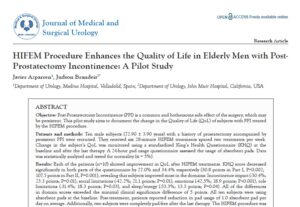
HIFEM procedure for Treatment of Persistent Urinary Incontinence
Post-Pelvic Organ Prolapse and Anti-Incontinence Surgery
The study aims to determine the effectiveness of the electromagnetic muscle stimulation (HIFEM) procedure as a form of postoperative pelvic floor physiotherapy on women who have undergone POP and anti-UI surgery.
Conclusions:
The data indicate that the HIFEM procedure significantly reduces the severity of lower urinary tract
symptoms including UI while improving the QoL in subjects with persistent post-surgery incontinence.
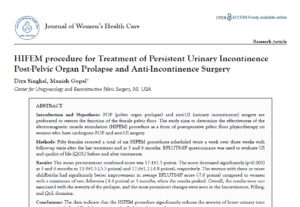
Prospective Multi-Center Study on Long-term Effectiveness of HIFEM Procedure for Treatment for Urinary Incontinence and Female Sexual Dysfunction
This study investigated the long-term efficacy of HIFEM-induced PFMs strengthening to reduce
UI and improve female sexual function.
Conclusions:
The study documents that the HIFEM procedure significantly improves the quality of life of patients
who are suffering from urinary incontinence and enhances female sexual function. Achieved results were seen to be sustained in a 1-year period. Considering the patient’s needs and expectations, re-treatment may be indicated.
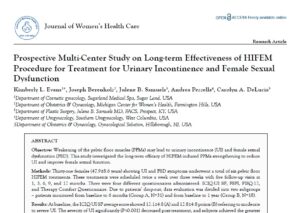
Electromyographic Evaluation of the Pelvic Muscles Activity After High-Intensity Focused Electromagnetic Procedure and Electrical
Stimulation in Women With Pelvic Floor Dysfunction
Besides electromagnetic stimulation, there are multiple ways to treat pelvic floor dysfunction including, medication, surgery, stimulation with electrical small electrical pulses.
Conclusions:
HIFEM was significantly more effective than electrical stimulation in treating PFD symptoms in postpartum women.
Reduced urinary incontinence | Increased sexual desire, sensitivity, ability to achieve orgasm | Reduced sexual pain
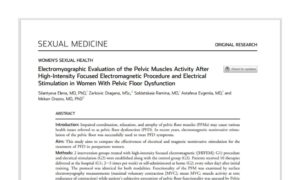
Sex Med 2020;8:282e289
A Comparative Study on the Effects of High-Intensity Focused Electromagnetic Technology and Electrostimulation for the
Treatment of Pelvic Floor Muscles and Urinary Incontinence in Parous Women: Analysis of Posttreatment Data
Weakness in the pelvic floor muscles can be the cause of urinary incontinence postpartum. HIFEM and electrical stimulation are two common non-invasive treatments. .
Conclusions:
HIFEM technology is suitable for the treatment of PFM weakening and showed to be more effective when compared with electrostimulation.
Visible changes to pelvic floor structures | Reduced urinary incontinence | Improved PFDI-20 scores
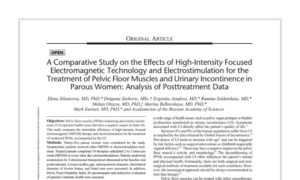
Female Pelvic Medicine & Reconstructive Surgery • Volume 00, Number 00, Month 2020
Safety and Efficacy of a Non‐Invasive High‐Intensity Focused Electromagnetic Field (HIFEM) Device for Treatment of Urinary Incontinence and Enhancement of Quality of Life
Urinary incontinence takes on many forms and interferes with everyday life including urge incontinence, stress incontinence and mixed incontinence.
Conclusions:
HIFEM technology is able to safely and effectively treat a wide range of patients suffering from urinary incontinence.
Reduced reliance on absorbent pads | Improvement in ICIQ-SF scores | Improved quality of life
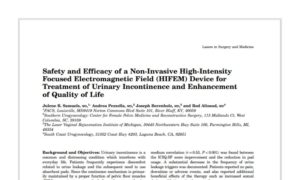
Julene B. Samuels, MD, 1* Andrea Pezzella, MD, 2 Joseph Berenholz, MD, 3 and Red Alinsod, MD4
The Use of HIFEM Technology in the Treatment of Pelvic Floor Muscles as a Cause of Female Sexual Dysfunction: A Multi-Center Pilot Study
Pelvic floor dysfunction can be the cause of reduced sexual function in women. They may experience limited arousal, inability to achieve orgasm and painful intercourse.
Conclusions:
HIFEM technology is a promising method in addressing women’s decreased sexual satisfaction.
Increased desire | Better lubrication | Greater satisfaction
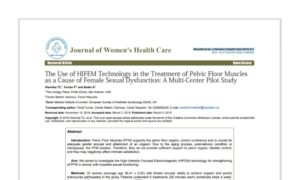
Hlavinka et al., J Women’s Health Care 2019, 8:1
HIFEM Technology – A New Perspective in Treatment of Stress Urinary Incontinence
Stress urinary incontinence (SUI) is a common condition among women, negatively affecting their quality of life.
Conclusions:
HIFEM technology is a promising approach for pelvic floor muscle stimulation that further improves the quality of life among SUI patients.
Less frequent leaks | Fewer hygienic pads | Improved Quality of Life
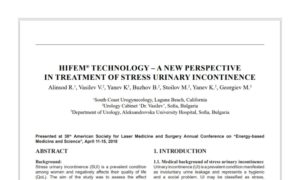
Presented at 38th American Society for Laser Medicine and Surgery Annual Conference on “Energy-based Medicine and Science”, April 11-15, 2018
HIFEM Technology – The Non-Invasive Treatment of Urinary Incontinence
Acknowledging the preference of many women to address UI in a non-surgical and discreet manner, the study reports on HIFEM treatment as a solution to this common problem.
Conclusions:
HIFEM technology significantly improves the QoL and reduces UI in post-partum and menopausal female patients who present with all types of UI.
Fewer urinary leakage episodes | No adverse events | Improved Quality of Life

Presented at 38th American Society for Laser Medicine and Surgery Annual Conference on “Energy-based Medicine and Science”, April 11-15, 2018
Randomized Multi-Center Trial of HIFEM Pelvic Floor Stimulation Device Compared with Pelvic Floor Exercises for Treatment of Urinary Incontinence: Evaluation of Initial Single-Center Data
Pelvic floor exercise is sometimes recommended for women experiencing urinary incontinence. Patients might benefit either from HIFEM or pelvic floor muscle training.
Conclusions:
The HIFEM procedure tended to have a higher impact on subjects by the means of objective and subjective examination.
Reduced use of pads | More comfortable | Improved quality of life
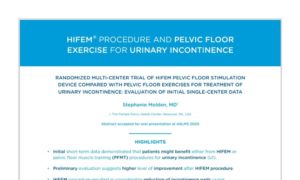
Presented at ASLMS 2020
Safety and Preliminary Efficacy of Magnetic Stimulation of Pelvic Floor with HIFEM Technology in Urinary Incontinence
A prospective study to evaluate the safety and preliminary effectiveness of the use of BTL EMSELLA magnetic stimulation in urinary incontinence.
Conclusions:
BTL Emsella is safe, well-tolerated and effective for the treatment of mild and moderate urinary incontinence.
Improved pelvic floor tone | Reduction in UI| Increased patient satisfaction
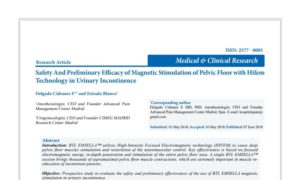
Med Clin Res, 2018 Volume 3 Issue 2
HIFEM™ Technology can Improve Quality of Life in Incontinent Patients
Urinary incontinence (UI) represents one of the most prevalent female intimate health issues negatively This study investigates the effect of High-Intensity Focused Electromagnetic technology (HIFEM) on QoL of incontinent patients.
Conclusions:
HIFEM technology leads to significant improvement in QoL of incontinent patients, maintains a patient’s privacy all while avoiding more invasive approaches.
More comfortable treatment option | Improvement in UI symptoms | Improved quality of life
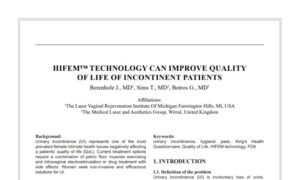
Female Sexual Function and Urinary Incontinence: Six Month Follow-Up After High-Intensity Focused Electromagnetic Procedure
Females showing a decreased interest in sexual activity evaluated six months after HIFEM treatment.
Conclusions:
Subjects’ continence and sexual function were been significantly improved.
Increased lubrication | Greater arousal | Increased orgasm intensity

Presented at North American Menopause Society 2020 Virtual Annual Meeting
